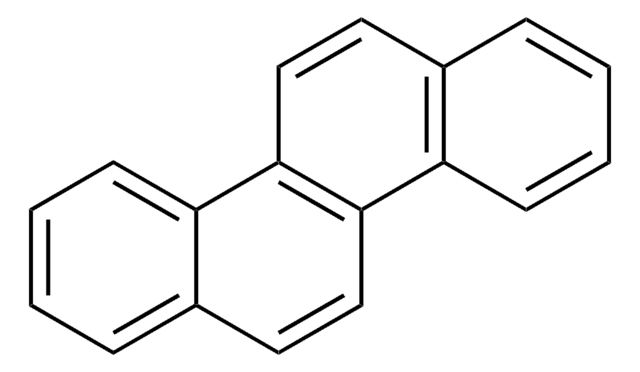Wszystkie zdjęcia(1)
Kluczowe dokumenty
BCR140
Benzo[c]chrysene
BCR®, certified reference material
Zaloguj sięWyświetlanie cen organizacyjnych i kontraktowych
About This Item
Wzór empiryczny (zapis Hilla):
C22H14
Numer CAS:
Masa cząsteczkowa:
278.35
Beilstein:
1876196
Numer MDL:
Kod UNSPSC:
41116107
Identyfikator substancji w PubChem:
NACRES:
NA.24
Polecane produkty
klasa czystości
certified reference material
agency
BCR®
producent / nazwa handlowa
JRC
metody
HPLC: suitable
gas chromatography (GC): suitable
format
neat
temp. przechowywania
2-8°C
ciąg SMILES
c1ccc2c(c1)ccc3c2ccc4ccc5ccccc5c34
InChI
1S/C22H14/c1-3-7-18-15(5-1)11-14-21-20(18)13-12-17-10-9-16-6-2-4-8-19(16)22(17)21/h1-14H
Klucz InChI
YZWGEMSQAMDWEM-UHFFFAOYSA-N
Komentarz do analizy
For more information please see:
BCR140
BCR140
Informacje prawne
BCR is a registered trademark of European Commission
Ta strona może zawierać tekst przetłumaczony maszynowo.
Kod klasy składowania
11 - Combustible Solids
Klasa zagrożenia wodnego (WGK)
WGK 3
Wybierz jedną z najnowszych wersji:
Certyfikaty analizy (CoA)
Lot/Batch Number
Przepraszamy, ale COA dla tego produktu nie jest aktualnie dostępny online.
Proszę o kontakt, jeśli potrzebna jest pomoc Obsługa Klienta
Masz już ten produkt?
Dokumenty związane z niedawno zakupionymi produktami zostały zamieszczone w Bibliotece dokumentów.
Shantu Amin et al.
Chemical research in toxicology, 16(2), 227-231 (2003-02-18)
Benzo[c]chrysene (BcC), an environmental pollutant, is a unique polycyclic aromatic hydrocarbon that possesses both a bay region and a fjord region in the same molecule. We previously demonstrated that both bay region and fjord region terminal rings are involved in
A Pal et al.
FEBS letters, 486(2), 163-166 (2000-12-13)
Carcinogenic activity of many polycyclic aromatic hydrocarbons (PAHs) is mainly attributed to their respective diol epoxides, which can be classified as either bay or fjord region depending upon the location of the epoxide function. The Pi class human glutathione (GSH)
A Luch et al.
Carcinogenesis, 19(4), 639-648 (1998-05-26)
Metabolic activation of the racemic benzo[c]chrysene-trans-9,10-, benzo[g]chrysene-trans-11,12- and dibenzo[a,l]pyrene-trans-11,12-dihydrodiols to fjord region syn- and anti-dihydrodiol epoxides by microsomes of Aroclor 1254-treated Sprague-Dawley rats has been examined. Since the fjord region dihydrodiol epoxides were hydrolytically unstable under the experimental conditions, their
A S Giles et al.
Chemical research in toxicology, 10(11), 1275-1284 (1997-12-24)
The metabolic activation in mouse skin of benzo[c]chrysene (B[c]C), a weakly carcinogenic polycyclic aromatic hydrocarbon (PAH) present in coal tar and crude oil, was investigated. Male Parkes mice were treated topically with 0.5 mumol of B[c]C, and DNA was isolated
Federica Nalin et al.
Analytical and bioanalytical chemistry, 410(3), 1123-1137 (2017-11-10)
Retention indices (I) for 45 polycyclic aromatic hydrocarbons (PAHs) and 63 methyl-substituted PAHs were determined by gas chromatography - mass spectrometry (GC-MS) using two different stationary phases: a Rxi-PAH phase (a "higher phenyl-content stationary phase") and a 50% (mole fraction)
Nasz zespół naukowców ma doświadczenie we wszystkich obszarach badań, w tym w naukach przyrodniczych, materiałoznawstwie, syntezie chemicznej, chromatografii, analityce i wielu innych dziedzinach.
Skontaktuj się z zespołem ds. pomocy technicznej